|
|
Remembering
Vietnam

Story of
THE VIETNAM VETERANS MEMORIAL
Tiffany Thanh Kieu
10 Grade – Katella High School
Anaheim - August 6,2003
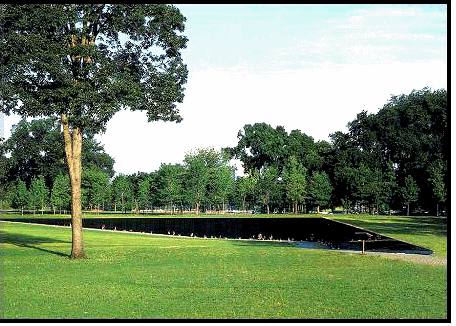
Vietnam Veterans
Memorial
Location:
The Constitution Gardens within the Mall, Washington D.C.
Black granite
Length: 493.5 feet long
Panels:
2 ľ inches thick, 40 inches wide; height varies from 8 inches to 10
feet, 1 inch
Size and weight: 3,000 cubic feet,
175 pounds per cubic foot;
total weight of granite without
foundation is 525,000 lbs.
Date construction began:
March 16, 1982
Date of dedication:
November 13, 1982
INTRODUCTION
America has always been a
land of pride and patriotism. Men and women who served their
country loyally would be recognized and rewarded. The United States
Capital had been a home to hundreds of memorials that recognize the
hard work and dedication of its devoted citizens. Some monuments,
like the Washington Monument or the Lincoln Memorial, “tower
impressively above the nation’s capital,” but despite its modest
size, the one memorial that had continuously gather the largest
number of spectators year after year was the Vietnam Veterans
Memorial. Thousands of people each year came to visit this “low,
shiny, black wall covered with names” of the missing and dead
soldiers that served in the long, rigorous years of the Vietnam War.
 The Vietnam War was not a war of or within the United States.
Rather, the United States had sent its soldiers to help the foreign
country of Vietnam’s civil war. American’s aid started in late 1959
when President Eisenhower had sent a few U.S. military advisors to
help train the South Vietnamese soldiers for their upcoming battle
against the Northern Vietnamese Communist. Yet by 1967, over half a
million Americans were fighting in Vietnam! These men and women
risked their lives and devoted their services to fighting a no-win
war for a country that was not even their own. They fought with
loyalty and bravery, and many even lost their lives. Yet when they
returned home, they were not received with open arms but rather with
hatred and insults from on-lookers who did not recognize their
courage but preferably focused on the killings and atrocities of
warfare. The bravery and services of the numerous Vietnam Veterans
were quickly forgotten, but for the men and women who had been
within the core of the misery could never forget the sorrow and
horror of what had happened.
The Vietnam War was not a war of or within the United States.
Rather, the United States had sent its soldiers to help the foreign
country of Vietnam’s civil war. American’s aid started in late 1959
when President Eisenhower had sent a few U.S. military advisors to
help train the South Vietnamese soldiers for their upcoming battle
against the Northern Vietnamese Communist. Yet by 1967, over half a
million Americans were fighting in Vietnam! These men and women
risked their lives and devoted their services to fighting a no-win
war for a country that was not even their own. They fought with
loyalty and bravery, and many even lost their lives. Yet when they
returned home, they were not received with open arms but rather with
hatred and insults from on-lookers who did not recognize their
courage but preferably focused on the killings and atrocities of
warfare. The bravery and services of the numerous Vietnam Veterans
were quickly forgotten, but for the men and women who had been
within the core of the misery could never forget the sorrow and
horror of what had happened.
It was not until the 1979 that Jan C.
Scruggs, Robert W. Doubek, and John Wheeler, all veterans of the
war, decided to create a memorial that would honor the soldiers who
died or were still missing in Vietnam. Jan Scruggs was raised in
Bowie, Maryland. After he graduated from High School he served with
the US Army’s 199 Light Infantry Brigade. After valiantly serving
his term in Vietnam he come home and attended American University in
Washington, D. C., where he obtained a master degree in counseling.
Jan keep thinking of thousands of others who died in the war. Their
country has done nothing to honor them. He makes up his mind. He is
going to make sure there is a special memorial for the Americans who
fought in the Vietnam War. It will list the name of all men and
women who went to Vietnam and never returned _ every last one.
Most people think Jan is crazy. What
does he know about memorials ? It will cost millions of dollars to
build one . How will he get the money ? Why would Americans want to
build a memorial for the Vietnam War anyway ? They just want to
forget it .
Jan goes right ahead. He holds
meetings. He makes speeches. At first no one listens, but then he
finds other veterans who like his idea. They agree with Jan that
ordinary Americans will want to contribute money to build a
memorial. They call themselves the Vietnam Veterans’ Memorial Fund.
Newspaper and TV reporters do stories
about the fund. Contributions begin to trickle in. A young girl who
lost her father in the war sends ten dollars. A vet with no job
sends five. The parents of a young man who had been killed in the
war sent a check for $ 25. Jan is full of hope, but after two months
he has only $ 144.50 . How will he ever be able to raise millions ?
The fund - raising effort received a
huge boost when Senator John Warner of Virginia donated $5,000 of
his own money and helped raise another $ 50,000 . One of the major
donors was a Texan, H. Ross Perot. Eventually, donations exceeded $
8,4 millions. The VVMF received private donations from more than
275,000 individuals.
U.S Senator Charles Mathias – a
Republican from Maryland who had opposed American involvement in
Vietnam, believed that a tribute to Vietnam Veterans could help heal
differences between Americans. So he surprised and pleased the VVMF
organizers by picking a two- acre site midway between two famous
capital landmarks : the Washington Monument and the Lincoln
Memorial. Senator Mathias introduced a bill for the site to become a
memorial. All one hundred U.S. Senators helped sponsor the
legislation. It was passed on June 30,1980 . A similar bill was
passed in the U.S. House of Representatives.
After more than a year of trying ,
something wonderful happens.
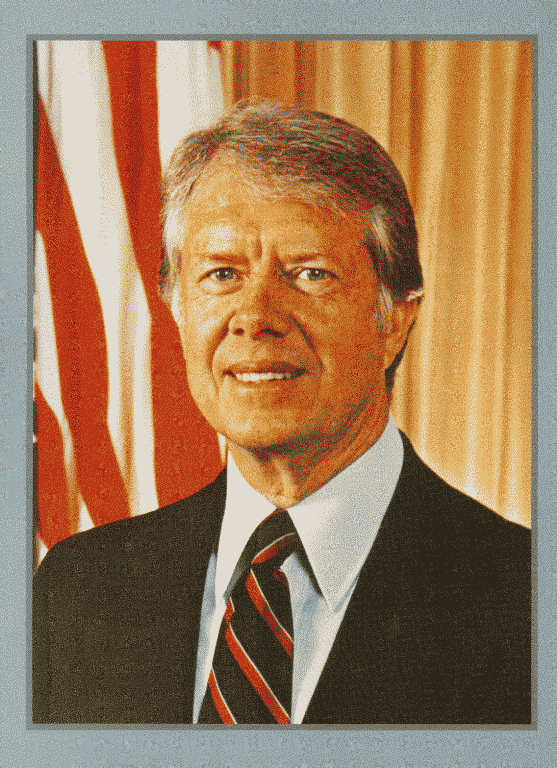 In summer of 1980, five years after
the last Americans left Vietnam, President Jimmy Carter signed a
bill that granted two acres of land for a memorial to Vietnam
veterans. The land was located on the National Mall , an open area
between the U.S Capital and the White House, which also contains the
Washington Monument, Lincoln Memorial, and Jefferson Memorial. In summer of 1980, five years after
the last Americans left Vietnam, President Jimmy Carter signed a
bill that granted two acres of land for a memorial to Vietnam
veterans. The land was located on the National Mall , an open area
between the U.S Capital and the White House, which also contains the
Washington Monument, Lincoln Memorial, and Jefferson Memorial.
Now
the vets are really on their way. People all over America begin to
help with the fund – raising. They want to do something to make up
for what had been a terrible time for America.
They feel the soldiers who had to
fight in Vietnam should be remembered Maybe
in this way something good can come out of the war.The
Memorial has become more than the dream of a few veterans. Now it is
the goal of thousands of Americans from coast to coast.
.
CONTEST.
The veterans decide to have a
nationwide contest. They choose important artists and builders to
judge it. Anyone over 18 years old can summit a design.
Jan’s original idea has not been
forgotten. So there is one important rule. The memorial must include
the name of every American man or woman killed or missing in the
war.
On March 31, 1981, the judges
received 1,421 entries in response to a contest .There are so many
they can’t fit them in an ordinary room. They have to put them in a
kind of huge hangar for airplanes.Then they look them over. The
judges want to be fair , so no name appear on the designs, only
numbers. That way the judges can’t tell who the artists are. They
have no problems choosing . Every judge agrees. The best design is
the one numbered 1,026.
 Who
is the winner ? Is it a famous artist ? A designer of many other
memorials ? Who
is the winner ? Is it a famous artist ? A designer of many other
memorials ?
No ! the designer of the winning
entry is a college student, a completely unknown 21-year-old woman.
Creating a design for the memorial had been a homework assignment.
She never dreamed that she would win !The woman ‘s name is
MAYA YING LIN.
She is a Chinese-
American. Her father’s name is
HENRY LIN,an
art professor at Ohio University and her mother ‘s name
JULIA CHANG LIN,
a professor of English and Asian Literature at Ohio
University .
She was born in 1959 in Athens, Ohio
An architect and sculptor , she comes from an artistically
distinguished Chinese family that immigrated to United States in the
1940s. She doesn’t know much about the Vietnam War. She was a baby
when America got into it. How did she create the prize- winning
design ?
Maya says she visited the spot in
Washington, D.C, where the memorial was to be build. She stood in
the grassy park on the gray November day. She though about how it
must feel to lose someone you love in the war. An idea come to her.
She wanted to cut open the earth. She imagined a black wall standing
between the sunny world and the great, dark world beyond that the
living can never enter. A great black wall with names on it.
The judges are proud of their choice.
So is Jan Scruggs. However, not everyone shared the judges’
opinion. A number of veterans and private organizations disagreed
against the design and had considered it to be “a black gash of
shame and sorrow.” They had expected a statue of brave soldiers in
battle, like a famous one that honors the solsiers of World War Two.
But many people liked the black wall. One was General William
Westmoreland, who had commanded U.S Foces in Vietnam. The yearlong
controversy over the design of the memorial was settled with a
compromising placement of a statue, a flag, and seals representing
five military services at the entrance plaza of the memorial
approximately 150 feet away. With the statue, flag, and seals
included, the protestors seemed to be more appreciative and
accepting of the memorial. The construction of the memorial was now
set to begin.
Construction workers, technicians,
artists, and landscapers commenced work on the memorial on March 16,
1982. Eight months later on November 13, 1982, Veterans Day
weekend, the memorial was dedicated in front of about 150,000
spectators who had made plans to be in the Mall specifically for the
memorable day. “Vietnam veterans, once ashamed or sad or angry,
hopped on buses, planes, and trains headed for the nation’s
capital. They were joined by parents who had lost sons, sisters who
had lost brothers, and friends who had lost friends. They filled
the hotels and motels in the Washington, D.C., area and overflowed
into private homes, parks, parked cars, and recreational vehicles.”
Visitors brought flowers, pictures, letters, and other gifts to
place alongside the names of the lost soldiers. The once forgotten
heroism of the Vietnam veterans would be forever honored with the
foundation of this respectable memorial.
CONSTRUCTION
The design of the
memorial was simplified to the maximum. It was just two triangular
panels that intersected at an angle where they come together is 125
degrees , 12 minutes. There are 140 pilings with the average depth
to bedrock 35 feet . The hight of the walls at the vertex is 10.1
feet . Nearly 60,000 names of MIA’s, POW’s, and soldiers that have
died during the battles in the Vietnam War would be etched onto the
panels themselves. Since the Vietnam Veterans Memorial was dedicated
, names have been added to the wall and changes made to the existing
names .Orinally the wall contained 57,939 names. The wall today has
more than 58,200 names. The purpose of the memorial was one of
simplicity. Its main function was to allow the visitors to reflect
upon the lives of the men and women whose names stood before them.
The significance was not the wall but the names.
The Department of Defense
determines which names are placed on the wall according to criteria
specified in Presidential Executive Orders from Presidents Johnson
and Nixon. Those orders specified Vietnam and adjacent coastal
waters , and later Laos and Cambodia, as a combat zone. Those who
have died as a result of Agent Orange–related diseases or post-
traumatic stress suicides are not included on the wall. Since the
Vietnam Veterans Memorial was dedicated , names have been added to
the wall and change made to the existing names. Originally the wall
contained 57,939 names. The wall today has more than 58,200 names.
On March 16,1982, workers
had begun prepping the site for the memorial. “Groundbreaking took
place on March 26, 1982. The Gilbane Building Company acted as the
general contractor, and the architectural firm of Cooper-Lecky
Partnership supervised the construction.” The first step was to
break in the site that would be the foundation for the wall. A
triangular ditch approximately ten feet deep, 250 wide, and
approximately 500 feet in length was cut into the ground to lay the
foundation for the memorial.
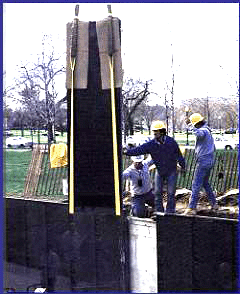 Maya Lin had designed the wall to be made purely of black granite.
However, large quantities of pure black granite were quite difficult
to find within the United States. Only three places in the entire
world mass-produced black granite: India, Sweden, and South Africa.
The black granite used for the construction of the walls, safety
curbs, and walkways of the memorial were brought in from Bangalore,
India. Once the stone arrived, it was then delivered to Barre,
Vermont where it was to be cut and fabricated. There are slight
variations in color and texture between the panels, the curbs, and
the walkways as a result of different finishing techniques of
polishing, honing, and flame treating.
Maya Lin had designed the wall to be made purely of black granite.
However, large quantities of pure black granite were quite difficult
to find within the United States. Only three places in the entire
world mass-produced black granite: India, Sweden, and South Africa.
The black granite used for the construction of the walls, safety
curbs, and walkways of the memorial were brought in from Bangalore,
India. Once the stone arrived, it was then delivered to Barre,
Vermont where it was to be cut and fabricated. There are slight
variations in color and texture between the panels, the curbs, and
the walkways as a result of different finishing techniques of
polishing, honing, and flame treating.
The wall was not made in
a continuous process but was split into segments. Workers
individually cut 148 panels in respect to their varied size and
shape. The panels all shared similarities of being two and
three-fourth inches thick and forty inches wide. However, some
panels were taller than others based on its placement within the
wall; the height of the panels ranged from eight inches to ten feet,
one inch. The segmented structure of the wall allowed the names to
be engraved onto the surface a lot more easily.
The wall would not have been finished
in time for dedication on Veterans weekend 1982 if all of the nearly
60,000 names were hand carved onto the wall. Each name was
imprinted onto the wall by a computerized process by Datalantic,
Incorporated in Atlanta, Georgia, called photo stencil gritblasting.
This special technique was developed by Larry Century specifically
for the Memorial. “The process is of a digitized typeface called
Optima. It involves a film negative at one-third in size from which
an enlargement is made, a film positive at full size.” The polished
granite would then be coated with a photosensitive emulsion. A
process similar to silk-screening was then used to transfer the
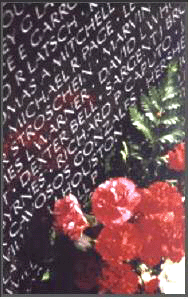 enlargement
to the stone. Once the process was complete, the stone within the
area of the letters was exposed and the remaining surface was
protected by the emulsion. The letters were .53 inches in size and
approximately .015 inches in depth. The lettering was light gray in
color, the natural color of the abraded stone, which contrasted
sharply with the polished black surface, allowing it extremely
legible. The initial inscription was done by Binswanger Glasscraft
Products, and the additional inscriptions done in the later ears
were done by Great Panes Glasswork, Incorporated with a coordinated
effort by Cooper-Lecky Architects. enlargement
to the stone. Once the process was complete, the stone within the
area of the letters was exposed and the remaining surface was
protected by the emulsion. The letters were .53 inches in size and
approximately .015 inches in depth. The lettering was light gray in
color, the natural color of the abraded stone, which contrasted
sharply with the polished black surface, allowing it extremely
legible. The initial inscription was done by Binswanger Glasscraft
Products, and the additional inscriptions done in the later ears
were done by Great Panes Glasswork, Incorporated with a coordinated
effort by Cooper-Lecky Architects.
Once the granite panels were
completed, they were set into place along the border of the
ready-made ditch. The curb and walkways were laid into place, and
the landscapers constructed the surrounding area to provide the
visitors with an area for meditation and contemplation. All the
details for the memorial were finished and ready for display.
Construction was completed in late October, and the wall was
dedicated on its designated date on Veterans weekend
UNIFICATION AND HEALING.
Despite its basic design, the Vietnam
Veterans Memorial conveys numerous values that constitutes with
heroism, reflection, and harmony. “…You feel you’re entering a
cloistered space, set off from the busy surroundings. Streets, and
skylines disappear to leave you alone with the wall and its names.
Then, as you pass the angle and begin to climb, you feel yourself
emerging again into the world of noise and light after a meditative
experience. At close range, the names dominate everything… The name
of the first soldier who died is carved at the angle of the wall,
and the names continue to the right in columns in chronological
order of date of death, out to the east en where the wall fades into
the earth. The names begin again, with the next soldier who died,
at the west end, where the wall emerges from the earth…”
The placement of the memorial itself
played a significant part in its meaning. Unlike the
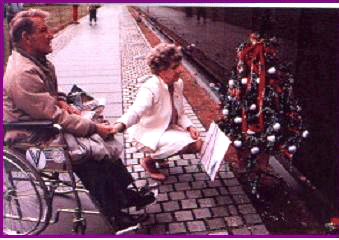 numerous
other memorials in Washington, D.C., the memorial was not placed
above ground level but rather cut into the ground itself to
represent the sharp, painful scare of loss and death. “I thought
about what death is, what a loss is. A sharp pain that lessens with
time, but can never quite heal over. A scar. The idea occurred to
me there on the site. Take a knife and cut open the earth, and with
time the grass would heal it. As if you cut open the rock and
polished it.” “I had an impulse to cut open the earth… an initial
violence that in time would heal. The grass would grow back, but
the cut would remain, a pure, flat surface, like a geode when you
cut it open and polish the edge…” numerous
other memorials in Washington, D.C., the memorial was not placed
above ground level but rather cut into the ground itself to
represent the sharp, painful scare of loss and death. “I thought
about what death is, what a loss is. A sharp pain that lessens with
time, but can never quite heal over. A scar. The idea occurred to
me there on the site. Take a knife and cut open the earth, and with
time the grass would heal it. As if you cut open the rock and
polished it.” “I had an impulse to cut open the earth… an initial
violence that in time would heal. The grass would grow back, but
the cut would remain, a pure, flat surface, like a geode when you
cut it open and polish the edge…”
The memorial was designed to be a
place of contemplation, an area where the visitor could reflect upon
the history and tragedies of the war. It allowed the guest a moment
in time alone with their memories, the names on the wall, and an
appreciation of the surroundings. “I chose black granite to make
the surface reflective and peaceful.” The viewer does not only see
the name as they gaze upon the names on the walls, but they can also
see themselves and the environment around them. They have become a
part of the wall, a part of this nation’s history. “The more the
visitors looked, the more they saw. The black granite wall
reflected faces, grass, falling leaves, and blue sky.” The wall was
not meant to an object of separation, but it was a device of
unification and healing. In order to heal, one must realize the
truth and face the reality within oneself.
So many names are etched onto the
wall; how would one be distinguished from the
 other?
How could one family’s Thomas Smiths be different from the other
fourteen Thomas Smiths who also died beside him? The significance
of the names would be abandoned if all 58,325 names had been
arranged in alphabetical order. Their stories and journeys would be
lost within a sea of deceased mentions. Maya Lin recognized this
disaster and wanted to give life to names by arranging them
chronological order by date of death. Although this method was time
consuming when it came to looking for the name, it made the person a
bit more special and significant from every other name on the wall.
The date of their death told a story of the events of that day and
could possibly serve as an explanation of how or why they died.
There are 1170 dots that can be used to help find a name within the
massive panels. Each dot marked ten lines and were located on the
even-numbered panels. other?
How could one family’s Thomas Smiths be different from the other
fourteen Thomas Smiths who also died beside him? The significance
of the names would be abandoned if all 58,325 names had been
arranged in alphabetical order. Their stories and journeys would be
lost within a sea of deceased mentions. Maya Lin recognized this
disaster and wanted to give life to names by arranging them
chronological order by date of death. Although this method was time
consuming when it came to looking for the name, it made the person a
bit more special and significant from every other name on the wall.
The date of their death told a story of the events of that day and
could possibly serve as an explanation of how or why they died.
There are 1170 dots that can be used to help find a name within the
massive panels. Each dot marked ten lines and were located on the
even-numbered panels.
The wall does not merely mention the
name of the individuals but also their state of being. Diamond and
plus signs were impressed beside each name to indicate whether a
person was confirmed dead or remained missing. The diamonds
indicated that a person’s death was confirmed. The cross-like plus
signs indicated that a person remained missing and unaccounted for
and no way were they meant to be a religious symbol. A plus symbol
could be easily turned into a diamond if the person was declared
dead in the event of their remains being found. In the case of an
M.I.A. returning home, a circle would be inscribed around the plus.
As of this time, no circles appear on the wall.
As a result, the memorial had become
an international icon of healing and closure for the many veterans
and family members who lived and fought through the Vietnam War.
Their valor, turmoil, sorrow, anticipation, and tears lay within the
black granite. An event that was once shadowed in the darkness of
history has now been brought to light for the entire world to
acknowledge and appreciate. From the moment that its idea was
developed to its stance on solid ground today, the memorial remains
a cherished symbol of the dedication and gallantry of the men and
women who devoted themselves to the service of their country
unconditionally. The dead and missing of the lingering war will
forever live within the hearts of the survivors and within the heart
of the Washington Constitution Gardens.
***&&&***
Mọi tin tức, bŕi vở muốn post tręn wesite xin email
bixitrum@yahoo.com
l
Trang chính
l
Chiến sĩ Vô Danh
l
Young Marines
l
Sư
Đoŕn TQLCVN l
Tin
tức nội bộ
l
Trang
Web bạn l |


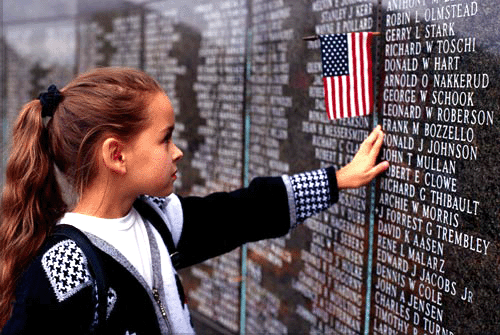




 The Vietnam War was not a war of or within the United States.
Rather, the United States had sent its soldiers to help the foreign
country of Vietnam’s civil war. American’s aid started in late 1959
when President Eisenhower had sent a few U.S. military advisors to
help train the South Vietnamese soldiers for their upcoming battle
against the Northern Vietnamese Communist. Yet by 1967, over half a
million Americans were fighting in Vietnam! These men and women
risked their lives and devoted their services to fighting a no-win
war for a country that was not even their own. They fought with
loyalty and bravery, and many even lost their lives. Yet when they
returned home, they were not received with open arms but rather with
hatred and insults from on-lookers who did not recognize their
courage but preferably focused on the killings and atrocities of
warfare. The bravery and services of the numerous Vietnam Veterans
were quickly forgotten, but for the men and women who had been
within the core of the misery could never forget the sorrow and
horror of what had happened.
The Vietnam War was not a war of or within the United States.
Rather, the United States had sent its soldiers to help the foreign
country of Vietnam’s civil war. American’s aid started in late 1959
when President Eisenhower had sent a few U.S. military advisors to
help train the South Vietnamese soldiers for their upcoming battle
against the Northern Vietnamese Communist. Yet by 1967, over half a
million Americans were fighting in Vietnam! These men and women
risked their lives and devoted their services to fighting a no-win
war for a country that was not even their own. They fought with
loyalty and bravery, and many even lost their lives. Yet when they
returned home, they were not received with open arms but rather with
hatred and insults from on-lookers who did not recognize their
courage but preferably focused on the killings and atrocities of
warfare. The bravery and services of the numerous Vietnam Veterans
were quickly forgotten, but for the men and women who had been
within the core of the misery could never forget the sorrow and
horror of what had happened.  In summer of 1980, five years after
the last Americans left Vietnam, President Jimmy Carter signed a
bill that granted two acres of land for a memorial to Vietnam
veterans. The land was located on the National Mall , an open area
between the U.S Capital and the White House, which also contains the
Washington Monument, Lincoln Memorial, and Jefferson Memorial.
In summer of 1980, five years after
the last Americans left Vietnam, President Jimmy Carter signed a
bill that granted two acres of land for a memorial to Vietnam
veterans. The land was located on the National Mall , an open area
between the U.S Capital and the White House, which also contains the
Washington Monument, Lincoln Memorial, and Jefferson Memorial. Who
is the winner ? Is it a famous artist ? A designer of many other
memorials ?
Who
is the winner ? Is it a famous artist ? A designer of many other
memorials ?  Maya Lin had designed the wall to be made purely of black granite.
However, large quantities of pure black granite were quite difficult
to find within the United States. Only three places in the entire
world mass-produced black granite: India, Sweden, and South Africa.
The black granite used for the construction of the walls, safety
curbs, and walkways of the memorial were brought in from Bangalore,
India. Once the stone arrived, it was then delivered to Barre,
Vermont where it was to be cut and fabricated. There are slight
variations in color and texture between the panels, the curbs, and
the walkways as a result of different finishing techniques of
polishing, honing, and flame treating.
Maya Lin had designed the wall to be made purely of black granite.
However, large quantities of pure black granite were quite difficult
to find within the United States. Only three places in the entire
world mass-produced black granite: India, Sweden, and South Africa.
The black granite used for the construction of the walls, safety
curbs, and walkways of the memorial were brought in from Bangalore,
India. Once the stone arrived, it was then delivered to Barre,
Vermont where it was to be cut and fabricated. There are slight
variations in color and texture between the panels, the curbs, and
the walkways as a result of different finishing techniques of
polishing, honing, and flame treating. 

